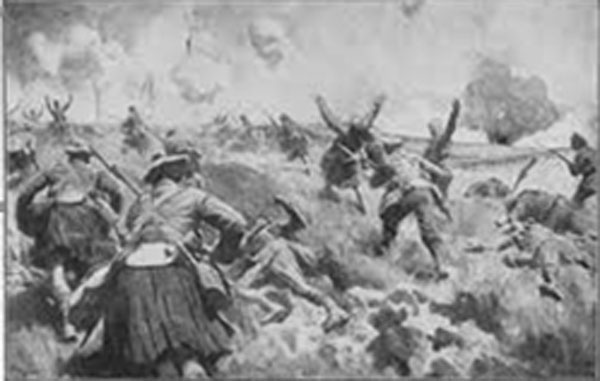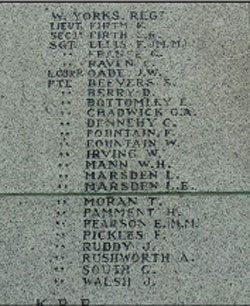
West Yorkshire (Prince of Wales Own) Regiment, 1st Battalion
Charlie Raven was born at Barnsley on 6th August 1892, the fifth son of six born to Norfolk born Police Constable John William and Lincolnshire born Emma Raven (nee Elvin) who married at Market Rasen, Lincolnshire on 18th March 1884. Charlie and his younger brother, George Frederick, born 27th November 1894, were both baptised at St. Mary’s Church, Barnsley on 31st December 1894.
In 1897 the couple had their seventh surviving child, an only daughter, Dorothy May. All of the children were born in Barnsley between 1885 and 1897 and all of their sons were of an age which might require them to serve in WWI.
By 1901 the family had moved to live at Ryecroft Street Ossett and by 1911 they had moved on to live at Hardy Street Brighouse where Charlie, aged 18 years, worked in a Dyers & Finishers.
By 4th August 1914 Great Britain and much of Europe were pulled into a war which would last 1,566 days, cost 8,528,831 lives and 28,938,073 casualties or missing on both sides.
Sadly Charlie’s brother, George Frederick Raven, died of his wounds on 25th November 1917, just two days before his 24th birthday and Charlie Raven was killed in action on 19th June 1918, aged 25 years. George Frederick’s biography (and all other Ossett Fallen biographies) can be seen only on the Ossett history website, Ossett Heritage at https://ossettheritage.co.uk/ossett-in-ww1/ossett-ww1-fallen/all/george-frederick-raven/
Charlie Raven at war
Charlie’s army service record has not survived making it difficult to be certain as to the date of his enlistment but it is known that he enlisted at Brighouse in the regular army 1st battalion West Yorkshire (Prince of Wales Own) Regiment, part of the 18th Brigade in the 6th Division. In August 1914 the 1st battalion was based in Lichfield moving later to that month to Dunfermline and ultimately to Cambridge.
The peacetime 6th Division of the pre-war regular army was quartered in Ireland and England at the outbreak of war in August, and was ordered on mobilisation to concentrate near Cambridge. By early September 1914 it was fully equipped and trained. The battalion landed at St. Nazaire (France) on 10th September 1914 but Charlie didn’t reach France until 28th December 1914. The Division arrived in time to reinforce the hard-pressed British Expeditionary Force on the Aisne front, before the whole BEF was moved north into Flanders and later to other locations on the Western Front, where it remained throughout the war.
Charlie’s first experience of trench warfare would be in 1915 and in July that year at the Battle of Hooge the German army deployed flamethrowers against the British for the first time.
 Depiction of German Flamethrowers. The Hooge Belgium July 1915.
Depiction of German Flamethrowers. The Hooge Belgium July 1915.
On 30th July 1915, the Germans using flame throwers (liquid fire as it was referred to) for the first time, had attacked and captured the crater and strong points at Hooge.
A closely co-ordinated artillery and infantry attack by the 6th Division on 9th August 1915 regained all the lost ground and was looked upon as a model of close co-operation between infantry and artillery. The attack was launched on the 9th August at 03.15 hours, with 18th Infantry Brigade on the right and the 16th Infantry Brigade on the left. The attack was completely successful; all objectives were quickly gained and a considerable number of prisoners taken. The captured position was subjected to a heavy artillery bombardment, which caused very heavy casualties in 18th Infantry Brigade, but was consolidated and held effectively.
The attack at Hooge is especially notable, as it was the first time that British troops attempted to follow their artillery barrage really closely.
As 1915 rolled into 1916 in April Charlie was treated at the 2nd General Hospital, located at Quai De Escales, Le Havre for treatment for boils and discharged three days later to duty with his battalion. We learn from the record that Charlie had been with the field force for 18 months, since October 1914, and that he was still a Private soldier at this time
Elsewhere in 1916 the 6th Division participated in the Battle of The Somme at Flers-Courcelette, Morval and Le Transloy.
Flers-Courcelotte. 21st September 1916. This battle of the Somme saw the first use of massed tanks as an offensive weapon. The British wanted a breakthrough by mid-September and before the onset of winter and on 15th September an attack was planned to involve 11 Divisions of infantry and mounted cavalry, supported by tanks and artillery across a front from Courcelette in the north, to Lesboeufs and Morval in the south. 6th Division’s objective was the heavily fortified Quadrilateral Redoubt, with secondary objectives of the villages of Lesboeufs and Morval. The Quadrilateral resisted all attempts to capture it and when the infantry arrived they found the wire uncut and impossible to penetrate. Four days of further attacks followed before the strong point was finally captured with 16th Infantry Brigade and 18th Infantry Brigade, 1st West Yorkshire Regiment and 14th Durham Light Infantry. The whole action cost the Division almost 3000 casualties
Morval. 25th September 1916. The Somme. Inclement weather held up the proposed attack as the 5th & 6th Divisions and the Guards advanced, taking Morval and Lesboeufs by late afternoon. The attack was preceded by an artillery bombardment which had opened up most of the German barbed wire defences. This caused delay and many casualties and the village was taken by British forces on 26th September.
Lesboeufs. 25th September 1916.On The Somme. Once in the village 6th Division advanced with the Guards Division; the area being held by the Germans. The attack began with 16th &18th lnfantry Brigades securing the open ground, whilst he other battalions passed through towards the village. Here the 1st West Yorkshire Regiment along with two companies of 14th Durham Light Infantry attacked on the left and performed one of the most successful operations of the Somme campaign with observation, an accurate preliminary bombardment and good creeping barrage. 6th Division alone captured over 500 prisoners, 6 machine guns, and 4 heavy trench mortars.
Transloy Ridges – 09/10/1916 On the first day of this later battle of The Somme, 6th Division were in reserve, returning to the front during the night of 8th and 9th October in preparation for the major attack on the 12th October with the 18th Infantry Brigade their objectives being a line of trenches between Gueudecourt and Le Transloy. The heavy ground meant 1st West Yorkshire Regiment were unable to take over the trenches. The attack was renewed on 15th October, with 18th Infantry Brigade attempting a further attack which succeeded, but with the loss of their Commanding Officer. The left attack made a little ground.
As a hectic and exhausting 1916 turned into 1917 the 6th Division readied themselves for action at The Battle of Hill 70 (15-25 August) and the Cambrai operations (Battle of Cambrai 1917) comprising The tank attack (20-21 November), The capture of Bourlon Wood (23-28 November) & The German counter-attacks (30 November-3 December).
On 23rd June 1917 Charlie Raven married Ida Summerscales at St. Matthews Church Rastrick. The registration tells us that by this time Charlie had been promoted to Sergeant and that his residence at the time of the marriage was Longroyd Hospital, Rastrick. Ida’s residence at the time of her marriage was Greetland, near Halifax. Ida’s post war address was 11, Coronation Street, Greetland.
Long Royd House, Rastrick (see below) opened as a military hospital on the 2nd November 1916 and closed on the 30th May 1919. The Commandant was Dr. Bogdan Edwards who also had responsibility for the other local military hospital at Boothroyd. The hospital was open for two years and seven months and during that time 893 patients received treatment with a total of 1,975 for the two hospitals at Long Royd and Boothroyd. The reason for Charlie’s visit to the Military Hospital is unknown as is the length of his stay at Rastrick and the date of his return to his Regiment; but return to the Front he did.
The reason for Charlie’s visit to the Military Hospital is unknown as is the length of his stay at Rastrick and the date of his return to his Regiment; but return to the Front he did.
For Charlie Raven 1918 saw the German Operation “Michael” and its component parts comprising St Quentin (21-23 March) and the German Operation “Georgette” comprising a series of battles in April which fell to the 71st Infantry Brigade thereby avoiding Charlie’s Brigade.
Sergeant 10364 Charlie Raven left the English shores for France on 28th December 1914 and whilst he was back in Blighty in 1917 for a while, hospitalised and married, he lived more conquests than most until he died on 19th June 1918, aged 25 years. Charlie died four days before his first wedding anniversary.
 Charlie Raven is Remembered with Honour at Etaples Military Cemetery LXVI.F.2. His wife, Ida (nee Summerscales) requested that the words on his Headstone should read HE NOBLY GAVE HIS MANHOOD STRENGTH FOR RIGHT. Ida remained a widow until her death in 1947.
Charlie Raven is Remembered with Honour at Etaples Military Cemetery LXVI.F.2. His wife, Ida (nee Summerscales) requested that the words on his Headstone should read HE NOBLY GAVE HIS MANHOOD STRENGTH FOR RIGHT. Ida remained a widow until her death in 1947.
During WWI, Etaples saw a large concentration of Commonwealth reinforcement camps and hospitals. It was remote from attack, except from aircraft, and accessible by railway from the northern or the southern battlefields. In 1917, 100,000 troops were camped among the sand dunes and the hospitals, which included eleven general, one stationary, four Red Cross hospitals and a convalescent depot, could deal with 22,000 wounded or sick. In September 1919, ten months after the Armistice, three hospitals remained. The cemetery contains 10,771 Commonwealth burials.
Sergeant Charlie Raven was posthumously awarded the British and Victory service medals and the 1914-15 Star medal. Charlie Raven is remembered at the Brighouse War Memorial as is his younger brother George Frederick Raven.
Charlie Raven will also be remembered at the Ossett War Memorial alongside his brothers and sisters in arms, one of whom is his younger brother, George Frederick Raven. We know them all as The Ossett Fallen.
Sources
Research by The Ossett Fallen Team. Biography by Alan Howe for Ossett Heritage. 19 January 2023
The Commonwealth War Graves Commission
https://www.cwgc.org/find-records/find-war-dead/casualty-details/505091/charlie-raven/